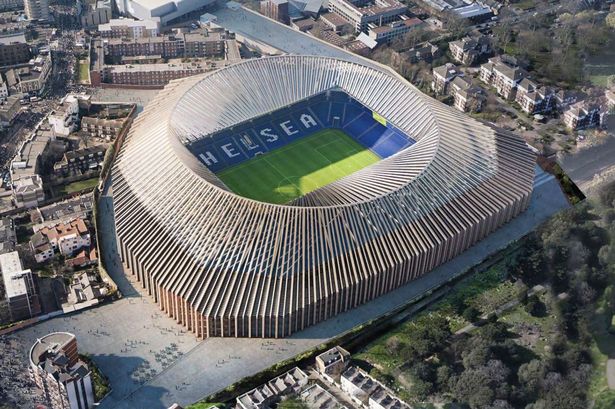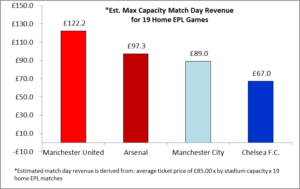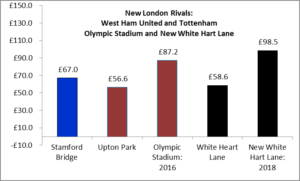Introduction
With all of the turmoil surrounding Chelsea F.C. due to the 2nd sacking of Jose Mourinho, and given the uncertainty regarding the future direction of this club, I wanted to take a serious look at the long-term financial sustainability of Chelsea F.C. The recent 2016 Deloitte Football Money League rankings have placed Chelsea F.C. 8th overall at an estimated £323 million in revenue for the 2014-15 season[1]. This position is down 1 spot from last year’s ranking of 7th and down 4 spots from their highest all-time ranking of 4th in the 2006-07 season.
Since Roman Abramovich took control of Chelsea F.C. in 2003, the Blues have seen their annual revenue grow from £110 million in 2003 to £314 million for the 2014-15, a compound annual growth rate of approximately +8.42%. But during this 13 year period, the Blues have only posted positive operating profits twice (in 2011-12 the year the won Champions League and 2013-14). In fact, the average operating loss during this 12 year period (including the 2 years of profit) is approximately -£57 million. Despite winning the Barclays Premier League and the Capital One Cup last year, Chelsea F.C. racked up a £23.1 million loss[2].
With Chelsea almost certain to miss next year’s Champions League (barring some dramatic/fantastic change in form), the Blues are in some jeopardy of slipping into financial uncertainty given their heavy reliance on non-controllable sources of income. The average financial hit to broadcasting revenue for failing to qualify for Champions League football has been estimated to be £35 million[3]. Furthermore, this lack of Champions League football will put a barrier on their ability to retain their top talent this summer, almost certainly forcing Chelsea F.C. to overhaul their player roster.
The easy answer is to simply just blame Chelsea F.C.’s forever growing wage bill with has grown at a compound annual rate of +10.9%[4]. But as you will see from this write up, there is far more to this story than simply reducing player wage bills. It is my opinion that the primary way for Chelsea F.C. to reduce its reliance on Champions League and to secure their long-term financial position is to invest in a larger stadium.
Revenue Sources for a European Football Club
The single most important measure of whether or not a football club has a puncher’s chance at financial sustainability is their ability to generate revenue from multiple sources. Traditionally, football clubs rely upon the following sources of revenues:
1. Match day revenue including tickets and corporate hospitality sales
2. Broadcast rights including distributions from participation in domestic leagues, cups, and European club competitions
3. Other commercial sources including sponsorships, merchandising, stadium tours, and other commercial operations
In the current world of European football, revenue sources have drastically changed over the last ten years with a majority of revenue coming from non-match day sources. This year’s Deloitte Football Money League report marks the lowest ratio of total revenue that has been comprised by match day revenue. The split between the three principle revenues sources for the majority of European football clubs is as follows[5]:
-
- Match day generates 19% of total revenue
- Broadcast rights generate 40% of total revenue
- Other commercial sources generate 41% of total revenue.
In contrast for Chelsea F.C., since the 2009-10 season, the Blues have driven 27% of their revenue from match day, 41% from broadcast rights, and 32% from other commercial sources[6]. Different to some of the other elite European football clubs, Chelsea F.C. is far more reliant upon match day revenue. With such a large sum of their revenue driven by match day, it is critical that Chelsea start actively planning for the long term and focus on the single most controllable and important source of income to the club: match day revenue.
Current Chelsea F.C. Match Day Revenue
Chelsea F.C. currently plays its home matches at Stamford Bridge which has a max capacity of 41,798 and in the current season, the Blues average attendance is 41,516[7]. Opened in 1877, max capacity at Stamford Bridge ranks 8th overall in the Barclay’s Premiere League while average attendance ranks 7th.
When you compare Stamford Bridge to Chelsea’s closet financial rivals, United, City, and Arsenal all have stadiums that are much larger than the Blues’:
-
- Manchester United’s average attendance at Old Trafford is 75,345 with a max capacity of 75,635. United’s home ground is 1.82 times larger than Stamford Bridge
- Arsenal’s average attendance at Emirates Stadium is 59,951 with a max capacity of 60,260. Arsenal’s home ground is 1.45 times larger than Stamford Bridge
- Manchester City’s average attendance at Etihad Stadium is 53,897 with a max capacity of 55,097. City’s home ground is 1.33 times larger than Stamford Bridge
With Chelsea’s current size limitations, at an average price of £85 per ticket, Chelsea F.C. is making roughly £3.5 million per home game and roughly £67.0 million annually for 19 home premier league matches.
Compared to its closet financial rivals, Chelsea F.C. makes £2.9 million less than United, £1.6 million less than Arsenal and £1.2 million less than City per home game. Given this discrepancy in home ground revenue, Chelsea F.C. is missing out on approximately £22 million to £30 million in match day revenue annually.
An absolute key component to Chelsea’s long-term financial stability will be to increase match day revenue on part with Arsenal and the two teams from Manchester.
A Minimum 60,000+ Capacity New Stadium is a Must
As I mentioned before, the average cost of missing out on Champions League football is £35 million, and this year’s performance by Leicester City and Tottenham shows that guaranteed top four finishes are no longer the norm for Chelsea F.C (just ask Liverpool F.C). Although this season might be a “one-time” aberration, it is absolutely vital for Chelsea F.C. to develop a bigger home ground to solidify and secure the future success of this football club.
When you look to the east of London and the north of London, you see two clubs in West Ham United F.C. and Tottenham Hotspurs F.C. who fundamentally have taken serious strides to do as much. Both the Hammers and the Spurs have long-term established plans to increase their stadium capacities from the mid-35,000 range. West Ham will be moving to the 54,000 seat Olympic Stadium for the 2016-17 season, while Tottenham will build a 61,000 capacity stadium to replace their current home ground for the 2018-19 season.
*West Ham United’s new 54,000 capacity home ground for the 2016-17 season. Their current home ground of Upton Park only holds 35,016[8]
*New White Hart Lane will cost £750 million and will seat well over 61,000 fans starting in 2018. Current White Hart Lane only seats 36,284[9]
Both of these aggressive moves will put West Ham United and Tottenham Hotspurs F.C. in a far more advantageous and financial stable position than the Blues:
I estimate that West Ham match day revenue will grow by +54% to £87 million while Tottenham match day revenue will grow by +68% to almost £100 million annually. It’s a no-brainier whatsoever that Roman Abramovich needs to double down on his belief in Chelsea F.C. and build the club a new stadium. But it wouldn’t be Chelsea F.C. if there wasn’t some wrinkle to this story…
What Is Preventing Chelsea F.C. from Building the 60,000+ Stadium of their Dreams?
In the 1970’s and 1980’s Chelsea F.C. suffered serious financial setbacks following a large scale attempt to renovate Stamford Bridge. In order to keep the club afloat, Stamford Bridge freehold (rights of ownership to the property) was sold to a property developer by the name of Marler Estates. In doing do, Chelsea F.C. ceded control of their own home ground.
This arrangement continued through the early 90’s until a group of Chelsea F.C. lifelong supporters founded the Chelsea Pitch Owners (CPO) and purchased the Stamford Bridge freehold, the pitch, and the Chelsea F.C. name. This move was made to ensure that Stamford Bridge could never again be sold to property developers not related to the club. At the same time though, it also ensured that any talk of a new stadium had to be passed by 75% of the members of the CPO.
***A quick aside… Guess who is the president of the Chelsea Pitch Owners? The one and only captain John George Terry***
This unique relationship between Chelsea F.C. and the CPO has put the club in a very tough position. They know that it is a must to increase the capacity of their home stadium, but the CPO have forced Chelsea F.C. to play their home games at Stamford Bridge or lose the right to use the Chelsea F.C. name (since the CPO own the rights to the name as well). So if you are forced to stay in your correct location but you know that you have to increase stadium capacity, what are you going to do Roman Abramovich?
Expand Stamford Bridge to 60,000+ and Move to Wembley Stadium in the short-term
Currently, Chelsea F.C. is in the planning and development stage of a 60,000+ expansion to their current home ground Stamford Bridge with the estimated cost of the project currently valued at £500 million[10]. During the three year period of construction starting in 2017, the Blues are planning to play their home games at Wembley Stadium which is a mere 10.6 miles from Stamford Bridge. Home matches at Wembley stadium will be restricted to 50,000 even though max capacity is 90,000, and the total annual cost to the Blues for rental of Wembley will be £20 million. The photo below is the current development design for the New Stamford Bridge by Swiss architects Herzog & de Meuron:
I have created a financial projection of this construction project and without question, this is absolute the right thing for the football club to invest in:
It still remains to be seen if this major redevelopment project will pass the major planning and economic obstacles that currently exist. But one thing is remarkably clear for Chelsea F.C…. In this day of rising Premiere League broadcast money and new upstart clubs like Leicester City, sustained match day revenue growth will have to be the primary means by which Chelsea F.C. ensures its financial future. With West Ham and Tottenham breathing down their necks, Chelsea’s current financial superiority is under pressure and a new stadium will go a long way to relieve some of this pressure.
[1]SPORTS BUSINESS GROUP. “Top of the table: Football Money League” Deloitte 1 Jan. 2016. Web Retrieved 1 Feb. 2016.
[2]Chelsea FC. “Financial results announced with FFP compliance maintained.” Chelsea FC Website. 23 Nov. 2015. Web Retrieved 2 Dec. 2015.
[3] KEEGAN, MIKE. “The cost of failing to qualify for the Champions League.” MailOnline. 17 Sept. 2015. Web Retrived 13 Feb. 2016.
[4] ZIEGLER, MARTYN. “Chelsea player wage bill the highest in the Premier League last season at £215.6m” Press Association. 8 Jan. 2016. Web Retrieved 1 Feb. 2016.
[5] SPORTS BUSINESS GROUP. “Top of the table: Football Money League” Deloitte 1 Jan. 2016. Web Retrieved 1 Feb. 2016.
[6] O’REILLY, LARA. “Samsung to Pull Chelsea FC Sponsorship: Turkish Airlines To Take Over With Larger Package.” Business Insider. 6 Oct. 2014. Web Retrieved 1 Feb. 2016








